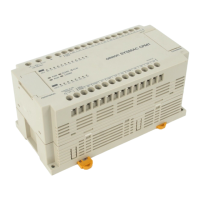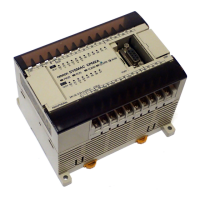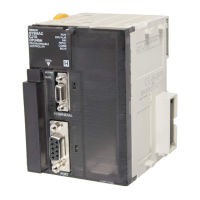32
executes the program and controls the PC. (3) Other Units, such as I/O Units,
Special I/O Units, and Link Units, which provide the physical I/O terminals corre-
sponding to I/O points. (4) The I/O Control Unit which provides connections to an
Expansion CPU Rack and Expansion I/O Racks. The I/O Control Unit is not re-
quired if an Expansion CPU Rack and Expansion I/O Racks are not connected
and connect be mounted to CVM1-BC103/053 Backplanes. (5) The Power Sup-
ply, which provides power to the CPU Rack.
A CPU Rack can be used alone or it can be connected to other Racks to provide
additional I/O points. The CPU Backplane provides slots to which other Units
can be mounted. Depending on the model of Backplane used, either three, five,
or ten slots are available for other Units.
An Expansion CPU Rack Consists of an Expansion CPU Backplane, a Power
Supply, and an I/O Interface Unit to connect to the CPU Rack. Eleven slots are
available for other Units. Up to 16 CPU Bus Units can be connected to the CPU
Rack and Expansion CPU Rack. Expansion I/O Racks can be connected to the
Expansion CPU Rack.
An Expansion CPU Rack cannot be connected to a CVM1-BC103/053 Back-
plane.
An Expansion I/O Rack can be thought of as an extension of the PC because it
provides additional slots to which other Units (except CPU Bus Units) can be
mounted. It is built onto an Expansion I/O Backplane to which a Power Supply
and other Units are mounted. Depending on the model of Backplane used, either
four, six, or 11 slots are available for other Units.
An I/O Interface Unit is also mounted to any Expansion I/O Rack to interface the
Rack to the CPU or Expansion CPU Rack. Also, an I/O Control Unit must be
mounted to any CPU Rack to which more than one Expansion I/O Rack is
mounted. If only one Expansion I/O Rack and no Expansion CPU Rack is con-
nected, the I/O Interface and I/O Control Units are not required and the Expan-
sion I/O Rack can be connected directly to the CPU Rack.
An Expansion I/O Rack is always connected to the CPU via the connectors on
the Backplanes, allowing communication between the two Racks. With C-series
Expansion I/O Racks, up to seven Expansion I/O Racks can be connected in
series to the CPU Rack. With CV-series Expansion I/O Racks, up to seven Ex-
pansion I/O Racks can be connected to the CPU Rack in two series. If an Expan-
sion CPU Rack is used, only six Expansion I/O Racks can be connected.
Only one Expansion I/O Rack cannot be connected to a CVM1-BC103/053
Backplane.
I/O words are allocated to Units mounted on the CPU, Expansion CPU, and Ex-
pansion I/O Racks by rack number, regardless of the order in which the Racks
are connected. The CPU Rack number is fixed at 0, so I/O bits are always allo-
cated first to Units on the CPU Rack. Never set the rack number of an Expansion
CPU or Expansion I/O Rack to 0.
Note The PC Setup can be used to control I/O word allocation to Racks and override
allocation by rack number. Refer to
Section 7 PC Setup
for details.
The rack numbers for Expansion CPU and Expansion I/O Racks are set with the
rack number switch (RACK No.) on the I/O Interface Unit mounted on the Rack.
Set the rack number with a standard screwdriver after turning off the Rack power
supply and be careful not to damage the switch groove.
Note 1. A duplication error will occur if 2 or more Racks have the same rack number.
2. If a rack number is set to 8 or 9, the Rack will not be recognized by the CPU.
3. If a single Expansion I/O Rack is connected to a CPU Rack, an I/O Interface
Unit is not required and the rack number of Expansion I/O Rack is fixed at 1.
4. When mounting an Interrupt Input Unit to an Expansion CPU Rack, always
set the rack number of the Expansion CPU Rack to 1.
Expansion CPU Racks
Expansion I/O Racks
Setting Rack Numbers
PC Configuration Section 2-7

